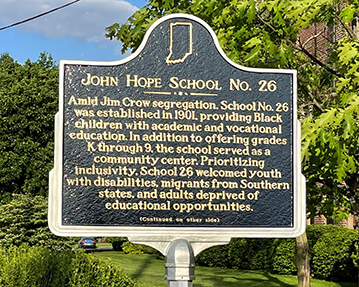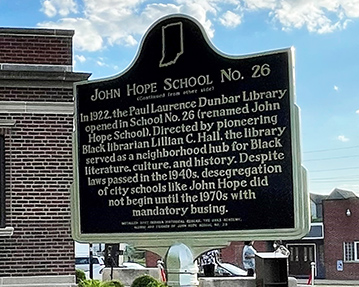John Hope School No. 26


Location:1301 E. 16th St., Indianapolis (Marion County), Indiana 46202
Installed 2022 Indiana Historical Bureau, The Oaks Academy, Alumni and Friends of John Hope School No. 26
ID#: 49.2022.2
Text
Side One
Amid Jim Crow segregation, School No. 26 was established in 1901, providing Black children with academic and vocational education. In addition to offering grades K through 9, the school served as a community center. Prioritizing inclusivity, School 26 welcomed youth with disabilities, migrants from Southern states, and adults deprived of educational opportunities.
Side Two
In 1922, the Paul Laurence Dunbar Library opened in School No. 26 (renamed John Hope School). Directed by pioneering Black librarian Lillian C. Hall, the library served as a neighborhood hub for Black literature, culture, and history. Despite laws passed in the 1940s, desegregation of city schools like John Hope did not begin until the 1970s with mandatory busing.
Annotated Text
Side One
Amid Jim Crow segregation, School No. 26 was established in 1901, providing Black children with academic and vocational education.[1] In addition to offering grades K through 9, the school served as a community center.[2] Prioritizing inclusivity, School 26 welcomed youth with disabilities, migrants from Southern states, and adults deprived of educational opportunities.[3]
Side Two
In 1922, the Paul Laurence Dunbar Library opened in School No. 26 (renamed John Hope School).[4] Directed by pioneering Black librarian Lillian C. Hall, the library served as a neighborhood hub for Black literature, culture, and history.[5] Despite laws passed in the 1940s, desegregation of city schools like John Hope did not begin until the 1970s with mandatory busing.[6]
[1] “Robert Becker’s Death,” Indianapolis News, February 12, 1901, 10, accessed Hoosier State Chronicles; Indianapolis Journal, June 8, 1901, 5, accessed Newspapers.com; “Routine Affairs,” Indianapolis Journal, September 21, 1901, 3, accessed Hoosier State Chronicles; “Colored School Exhibition,” Indianapolis News, May 9, 1902, 13, accessed Newspapers.com; “Colored Training School Exhibition,” Indianapolis News, May 14, 1902, 5, accessed Newspapers.com; “Manual Work and Cooking Classes in the Indianapolis Colored Schools,” Indianapolis Recorder, May 31, 1902, 1, accessed Newspapers.com; Indianapolis Recorder, October 17, 1908, 1, accessed Hoosier State Chronicles; “Social Service Meetings,” March 30, 1912, Indianapolis Recorder, 1, accessed Hoosier State Chronicles; “School No. 26, for Colored Bots and Girls, May Be the Little Tuskegee of Indianapolis Educational System,” Indianapolis Recorder, November 16, 1913, accessed Hoosier State Chronicles; “Closing Exercises and Exhibition of Night School Number 26,” Indianapolis Recorder, April 24, 1915, 4, accessed Hoosier State Chronicles; John Dewey and Evelyn Dewy, Schools of To-Morrow (New York: E. P. Dutton & Company, 1915), Chapter 8.
[2] Indianapolis Recorder, June 18, 1904, 2, accessed Hoosier State Chronicles; Indianapolis Recorder, July 10, 1909, 2, accessed Hoosier State Chronicles; “Closing of Evening School No. 26,” Indianapolis Recorder, April 15, 1911, accessed Hoosier State Chronicles; “Social Service Meetings,” March 30, 1912, Indianapolis Recorder, 1, accessed Hoosier State Chronicles; “East End Civic League Meeting,” Indianapolis Recorder, April 27, 1912, 1, accessed Hoosier State Chronicles; “Shower Baths at Colored Boys Club House,” Indianapolis Recorder, June 28, 1913, 1, accessed Hoosier State Chronicles; “School No. 26, for Colored Bots and Girls, May Be the Little Tuskegee of Indianapolis Educational System,” Indianapolis Recorder, November 16, 1913, accessed Hoosier State Chronicles; John Dewey and Evelyn Dewy, Schools of To-Morrow (New York: E. P. Dutton & Company, 1915), Chapter 8; Indianapolis Recorder, April 29, 1916, 2, accessed Hoosier State Chronicles; “Festival at School 26 Draws Many Visitors,” Indianapolis News, July 28, 1916, 9, accessed Newspapers.com; “School Work Will Be Shown,” Indianapolis News, June 8, 1929, 34, accessed Newspapers.com; “School Notes,” Indianapolis Recorder, May 11, 1935, 6, accessed Hoosier State Chronicles; “School 26 Launches Plans for E’Side Victory Gardens,” Indianapolis Recorder, April 3, 1943, 1, accessed Hoosier State Chronicles; “Eastside Schools Stage Clean-up Drive Parades,” Indianapolis Recorder, May 19, 1951, 1, accessed Hoosier State Chronicles; “Parent-Pupil Arts, Craft Courses to Open at School 26,” Indianapolis Star, April 23, 1952, 3, accessed Newspapers.com; “Clearing of Slum Area Will Provide Northeast Side with Big Playground,” Indianapolis Star, April 10, 1955, 21, accessed Newspapers.com; Oral History Interview, Abie Dean Robinson, Jr. and Ron Lovett, John Hope School No. 26 Alumni, June 1, 2021, submitted by applicant.
[3] “Night School Opened with Large Number,” Indianapolis Recorder, October 25, 1913, 8, accessed Hoosier State Chronicles; “Closing Exercises and Exhibition of Night School Number 26,” Indianapolis Recorder, April 24, 1915, 4, accessed Hoosier State Chronicles; “More Than 2,000 Enroll in Adult Education Classes; Interest Wide,” Indianapolis Star, January 4, 1934, 2, accessed Newspapers.com; “Board to Open Bids Today on New Structure,” Indianapolis Times, November 19, 1935, 18, accessed Hoosier State Chronicles; Correspondence, Paul C. Stetson, Chairman, Crippled Children’s Committee to the Board of Directors, Indianapolis Rotary Club, June 8, 1936, accessed digitalindy.org; “Plans Jim Crow Unit for Crippled Children,” Indianapolis Recorder, January 30, 1937, 1, accessed Hoosier State Chronicles; “Opens at School 26,” Indianapolis Recorder, February 5, 1938, 1, accessed Hoosier State Chronicles; “Summer School Open to Adults,” Indianapolis Recorder, June 13, 1942, 3, accessed Hoosier State Chronicles; “Home-Help Course to Be Free,” Indianapolis News, March 23, 1967, 21, accessed Newspapers.com; “Only 2 Pupils, but Class Will Continue,” Indianapolis News, April 5, 1967, 28, accessed Newspapers.com; “Adult Learning Center Opens at School 26,” Indianapolis Star, December 23, 1973, 29, accessed Newspapers.com; “Schooling for Adults Is Free,” Indianapolis News, October 13, 1975, 29, accessed Newspapers.com; Living and Learning in the Indy Public Schools (no date), p. 37, accessed digitalindy.org
[4] “School Board Makes Appointments,” Indianapolis Times, June 10, 1921, 8, accessed Hoosier State Chronicles; “Branch Extends Hours,” Indianapolis Times, October 29, 1923, 7, accessed Hoosier State Chronicles; Indianapolis Public Library Five Year Survey 1917-1922, p. 20, accessed digitalindy.org; “Interesting Plays to Be Given School,” Indianapolis Recorder, May 14, 1932, 6, accessed Hoosier State Chronicles; “Named, Wide Service,” Indianapolis Recorder, April 23, 1938, accessed Hoosier State Chronicles; “Big Elementary Junior High School Grew from Small Institution Housed in Church,” Indianapolis Times, March 27, 1949, 10, submitted by applicant; S.L. Berry with Mary Ellen Gadski, Stacks: A History of the Indianapolis-Marion County Public Library (Indianapolis Public Library, 2011), 103.
[5] “School Board Makes Appointments,” Indianapolis Times, June 10, 1921, 8, accessed Hoosier State Chronicles; Newsletter, Readers’ Ink Indianapolis Library Service no. 9 (May 1923), n.p., accessed digitalindy.org; “New Dunbar List,” Indianapolis Times, May 29, 1923, 9, accessed Hoosier State Chronicles; “Branch Extends Hours,” Indianapolis Times, October 29, 1923, 7, accessed Hoosier State Chronicles; “Lillian C. Hall, Former Librarian, Succumbs in Home,” Indianapolis Recorder, April 26, 1958, 1, accessed Hoosier State Chronicles; Lawrence J. Downey, A Live Thing in the Whole Town: The History of the Indianapolis-Marion County Public Library, 1873-1990 (Indianapolis Marion County Library Foundation: 1991), 67-68, 157; S.L. Berry with Mary Ellen Gadski, Stacks: A History of the Indianapolis-Marion County Public Library (Indianapolis Public Library, 2011), 103, 153; Michele T. Fenton, “Stepping Out of Faith: Lillian Haydon Childress Hall, Pioneer Black Librarian,” Indiana Libraries 33, no. 1 (2014), accessed IUPUI.edu.
[6] “Seek Relief in ‘Hardship Cases’ of Schools J’crow,” Indianapolis Recorder, September 27, 1947, 1, accessed Hoosier State Chronicles; “How Ind. Lawmakers Voted on School Bill,” Indianapolis Recorder, March 12, 1949, 7, accessed Hoosier State Chronicles; “Uncertainty Bogs Integration Plan as Kids Return to School,” Indianapolis Recorder, September 1, 1951, 1, accessed Hoosier State Chronicles; “4 Grade School Limits Shifted to Ease Load,” Indianapolis Star, January 13, 1954, 10, accessed Newspapers.com; Howard Smulevitz, “Proposals for Desegregation of Grade Schools to Be Heard,” Indianapolis Star, March 6, 1971, 13, accessed Newspapers.com; Philip Allen, “Reshuffle of City Pupils to Affect 2,350 by Monday,” Indianapolis News, October 1, 1973, 1, accessed Newspapers.com; Letter to the Editor, Nickie Coffman, “Reports Injury in Busing Incident,” Indianapolis News, December 1, 1973, 10, accessed Newspapers.com; Diane Frederick, “School’s Out—But Some People Not Happy About It,” Indianapolis News, June 9, 1979, 15, accessed Newspapers.com; “Board to Act on Deseg Plan,” Indianapolis News, March 30, 1981, 1, accessed Newspapers.com; Letter to the Editor, Judy Chroniak, “Giving Busing a Try,” Indianapolis News, May 14, 1981, 17, accessed Newspapers.com; Deborah Pines, “Official Warns IPS to Guard Against Staff Segregation,” Indianapolis Star, December 18, 1985, 33, accessed Newspapers.com; Marcella Fleming, “Judge’s Ruling Prompts Questions; Here are Some Answers,” Indianapolis Star, February 28, 1997, 2, accessed Newspapers.com.
To learn more about John Hope School No. 26, see: Digital Encyclopedia of Indianapolis; The Glories of Our Journey: A Community Story; Lawrence J. Downey, A Live Thing in the Whole Town: The History of the Indianapolis-Marion County Public Library, 1873-1990 (Indianapolis Marion County Library Foundation: 1991); S.L. Berry with Mary Ellen Gadski, Stacks: A History of the Indianapolis-Marion County Public Library (Indianapolis Public Library, 2011).
Keywords
Education & Library; African American
